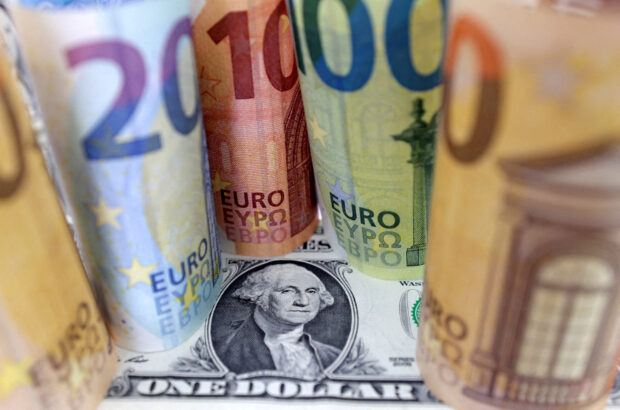
U.S. Dollar and Euro banknotes are seen in this illustration taken July 17, 2022. REUTERS/Dado Ruvic/Illustration/File Photo
SINGAPORE —The dollar was steady on the first trading day of the year as traders weighed the prospect of steep interest rate cuts from the Federal Reserve in 2024 and looked to economic data this week for clues on the central bank’s next moves.
The dollar index, which measures the U.S. currency against six rivals, fell 2 percent in 2023, snapping two years of gains, and was last at 101.43, up 0.049 percent on Tuesday.
Markets are now pricing in an 86 percent chance of rate cuts to start from March, according to CME FedWatch tool, with over 150 basis points (bps) of easing anticipated in the year.
“The question is when and how fast rate cuts will be delivered,” Marc Chandler, chief market strategist at Bannockburn Global Forex, said in a note.
READ: With rate hikes likely done, Fed turns to timing of cuts
“Moderating price pressures and weaker growth impulses have seen the pendulum of market sentiment swing dramatically from the ‘higher for longer’ mantra of most of last year to pricing in aggressive easing” from central banks, Chandler said.
The focus now switches to a slew of economic data due this week, including the data on job openings and nonfarm payrolls. Minutes from the last Fed meeting in December are scheduled for release on Thursday and will provide insight into the central bankers’ thinking around rate cuts this year.
Dovish Fed
At its December policy meeting, the Fed adopted an unexpectedly dovish tone and forecast 75 basis points in rate reductions for 2024.
That contrasted with other major central banks, including the European Central Bank (ECB) and Bank of England (BoE), which reiterated they will hold rates higher for longer.
READ: ECB keeps rates on hold, rejects talk of future cuts
Still, traders are pricing in 158 bps of cuts by the ECB this year, while the BoE is also expected to cut rates by 144 bps in 2024.
The euro was down 0.07 percent to $1.1036, inching away from the five-month peak of $1.11395 it touched last week. The single currency gained 3 percent last year, its first yearly gain since 2020.
Sterling was last at $1.2726, up 0.02 percent on the day, having clocked its strongest yearly performance last year since 2017 with a 5- percent gain.
Meanwhile, the Japanese yen weakened 0.24 percent to 141.20 per dollar to start the year on the back foot, having slid 7 percent against the dollar in 2023.
The spotlight is squarely on whether the Bank of Japan will exit negative interest rates in 2024, even as the central bank continues to stand by its dovish line. Tokyo markets are closed for a holiday, keeping volumes light on the day.
READ: BOJ plans to exit from easy policy next year but needs some good fortune
A powerful earthquake that hit central Japan on New Year’s Day killed at least six people, as authorities early on Tuesday reported bodies being pulled from the rubble of collapsed buildings.
Elsewhere, the Australian dollar was little changed at $0.6813, having ended 2023 broadly flat. The New Zealand dollar was 0.08 percent lower at $0.6314.